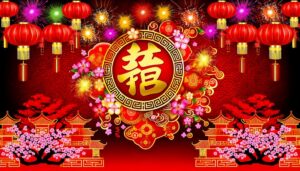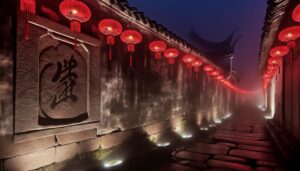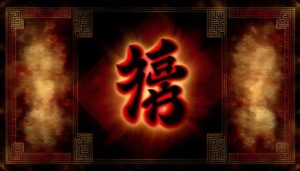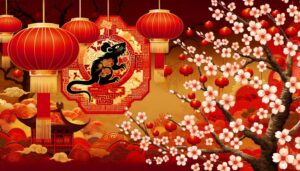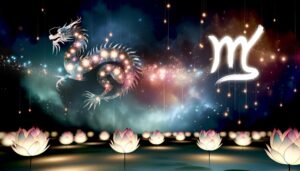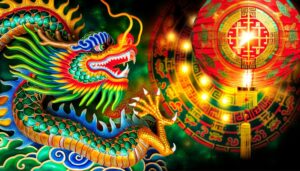What Are Chinese Symbols for Wealth and Prosperity?
The Chinese symbol for wealth and prosperity, 福 ('fú'), has deep historical roots dating back to the Shang Dynasty, emphasizing agricultural abundance and socio-cultural harmony. Symbolic of material wealth, familial bonds, and inner peace, the character is widely integrated into various aspects of Chinese life.
During Lunar New Year, it is often displayed on red paper cutouts and decorations to invoke fortune. In traditional and modern contexts, 福 represents aspirations for economic growth and personal success.
Calligraphy featuring this character — in various styles from Seal Script to Grass Script — diversifies its aesthetic appeal and cultural significance, offering layers of fascinating meanings. Explore further to uncover the intricate beauty and historical depth of this emblematic symbol.
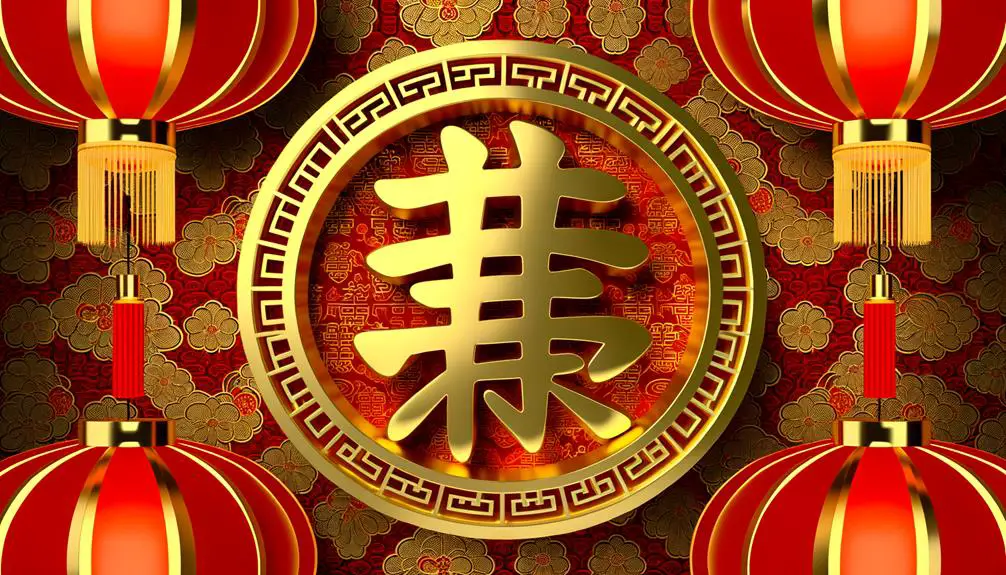
Key Takeaways
- The Chinese character for wealth and prosperity is 富 (fù).
- It evolved from oracle bone scripts during the Shang Dynasty.
- Traditionally used in Lunar New Year, weddings, and business settings.
- Symbolized through red envelopes, decorative items, and calligraphy.
- Emphasizes material wealth, strong family bonds, and societal status.
Historical Origins
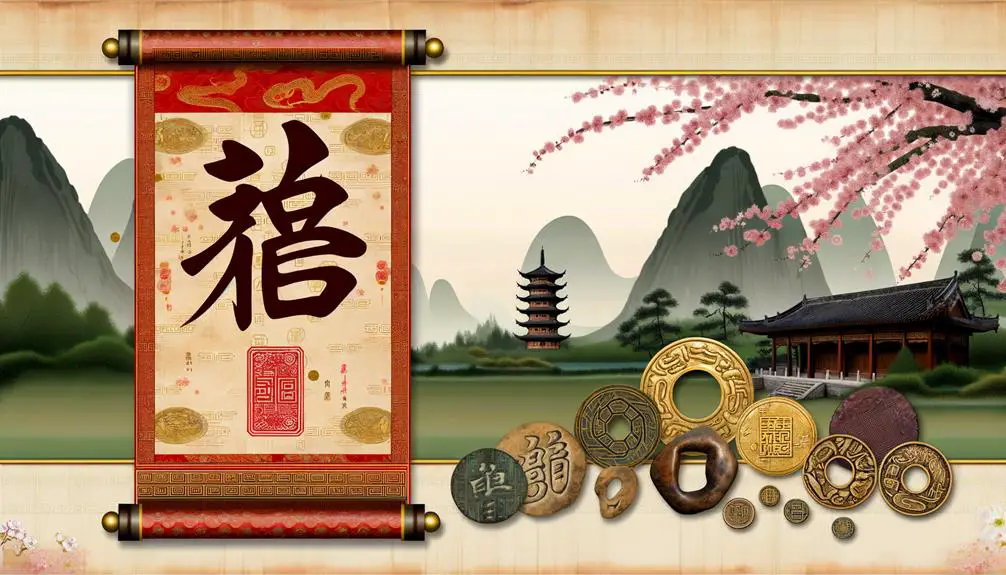
The historical origins of the Chinese symbol for wealth and prosperity can be traced back to ancient Chinese civilization, where it was deeply embedded in both linguistic and cultural practices.
The character “富” (fù), denoting wealth, first appeared in oracle bone scripts during the Shang Dynasty (1600-1046 BCE). These early inscriptions, primarily on ox bones and tortoise shells, reveal the significance of prosperity in agricultural society.
Archaeological findings indicate that the symbol evolved through the Zhou and Han Dynasties, reflecting shifts in socioeconomic structures. Additionally, Confucian principles, emphasizing social harmony and familial prosperity, further reinforced the symbol's prominence.
This enduring legacy exemplifies the intricate interplay between written language and cultural values in shaping historical perspectives on wealth.
Symbolism and Meaning
Embedded within the fabric of Chinese culture, the symbol for wealth and prosperity (富, fù) carries profound layers of meaning that extend beyond mere economic affluence. It intricately intertwines with aspects of social status, spiritual well-being, and familial harmony. This symbol is a crucial element in understanding the holistic view of prosperity in Chinese society.
- Social Status: Elevation of one's position within the community.
- Spiritual Well-being: Alignment with cosmic order and inner peace.
- Familial Harmony: Strengthening of family bonds and legacy.
- Longevity: Associated with a long, fulfilling life.
- Abundance: Encompassing not only material wealth but also richness in relationships and knowledge.
Each aspect symbolizes a multifaceted, culturally rich interpretation of prosperity.
Traditional Uses
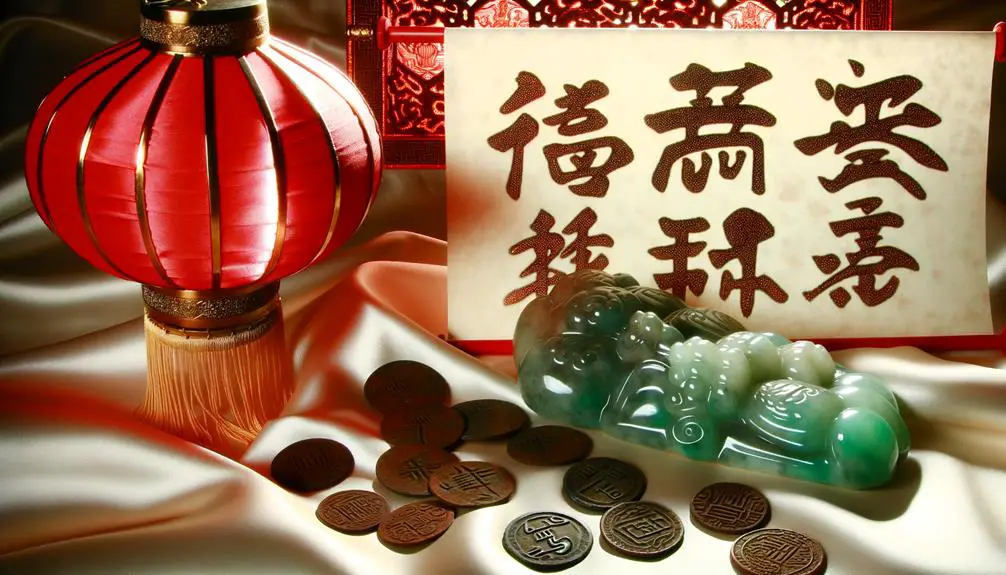
In traditional Chinese culture, the symbol for wealth and prosperity (富, fù) prominently features in various rituals, festivals, and everyday practices, serving as a powerful emblem of aspirational values and societal ideals.
During the Lunar New Year, red paper cutouts of the character are often displayed on doors and windows to invite prosperity for the coming year.
Additionally, the symbol is intricately involved in ceremonial practices, such as weddings, where it signifies future financial stability and abundance.
In daily life, this symbol is frequently seen in businesses, homes, and even on personal items like jewelry and clothing, reflecting a deep-rooted cultural emphasis on economic well-being and success.
Such traditional uses underscore its enduring importance in Chinese society.
Artistic Representations
Within the domain of artistic representations, the Chinese symbol for wealth and prosperity (富, fù) manifests across a diverse array of mediums, each imbued with cultural significance and historical depth. These mediums not only celebrate the symbol but also act as conduits of cultural heritage and artistic expression.
- Intricately carved jade sculptures: Revered for their auspicious properties, jade pieces often feature the fù symbol, encapsulating the essence of prosperity.
- Elaborate calligraphy scrolls: Master calligraphers render the symbol in flowing, elegant strokes, embodying both artistic and spiritual richness.
- Porcelain vases and ceramics: Adorned with the fù character, these items are treasured for their beauty and symbolism in Chinese households.
- Traditional ink paintings: Often featuring the fù symbol alongside other auspicious elements like dragons and phoenixes.
- Silk embroidery: This medium intricately stitches the fù character, merging textile art with cultural motifs.
Feng Shui Applications
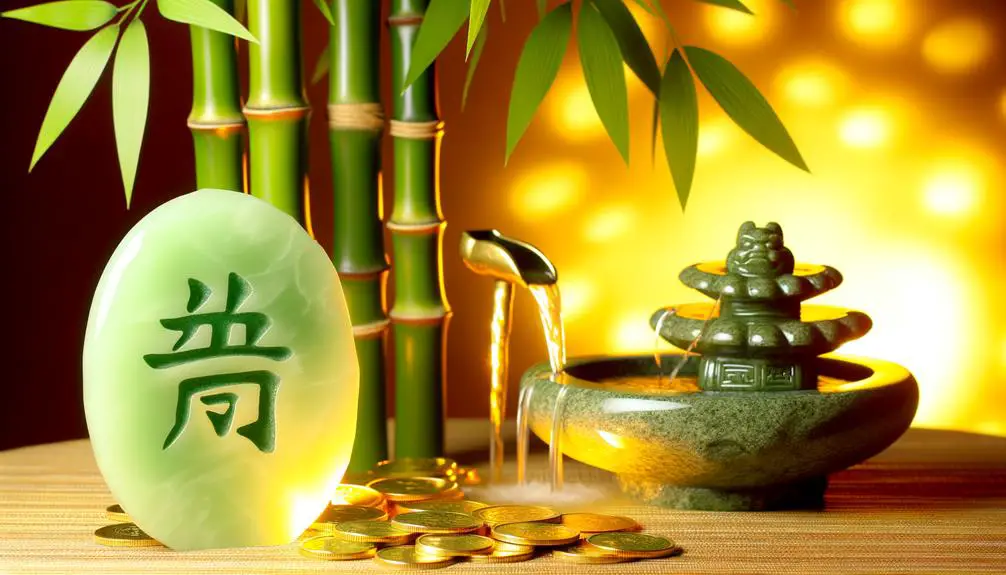
In Feng Shui practice, the strategic placement of the Chinese symbol for wealth and prosperity within one's home is essential to maximizing its potential benefits.
This symbol is often positioned in areas believed to enhance the flow of positive energy, such as the wealth corner, which corresponds to the southeast sector of the home.
Proper positioning is thought to magnify the auspicious energies and promote financial well-being and abundance.
Placement in Home
Strategically positioning the Chinese symbol for wealth and prosperity within the home according to Feng Shui principles can greatly enhance the flow of positive energy, thereby promoting financial abundance and overall well-being. This practice draws from centuries-old traditions and meticulous research into the harmonization of living spaces.
Understanding the best placement is essential for maximizing the symbol's potent effects.
- Entrance Hall: Positioning the symbol near the main entrance invites prosperity into the home.
- Living Room: Placing it in the living room guarantees that wealth energy permeates communal spaces.
- Wealth Corner: According to the Bagua map, the southeast corner is the designated wealth sector.
- Home Office: Displaying the symbol here promotes career success and financial growth.
- Dining Room: Ensures sustenance and abundance in daily life.
Enhancing Energy Flow
To further amplify the beneficial effects of the Chinese symbol for wealth and prosperity, emphasizing specific Feng Shui applications that optimize energy flow throughout the living space is essential. Proper placement and orientation of this symbol can greatly enhance the chi, or life force, thereby promoting financial well-being and abundance.
| Feng Shui Application | Description |
|---|---|
| East Sector | Enhances family harmony and health. |
| Southeast Sector | Directly boosts wealth and prosperity. |
| North Sector | Supports career growth and opportunities. |
| Living Room | Encourages communal prosperity. |
Correctly integrating these applications requires an understanding of the Bagua map, which links different areas of the home to specific life aspects. This culturally rooted practice ensures that the symbol's energies are harmoniously distributed, fostering an environment conducive to growth and success.
Cultural Significance
The Chinese symbol for wealth and prosperity, 富 (fù), holds profound cultural significance, deeply rooted in centuries of tradition and belief. This symbol is not merely an emblem but a reflection of the values and aspirations within Chinese culture. Throughout history, 富 has been associated with abundance, success, and good fortune. It is often displayed prominently in homes and businesses to attract positive energy and financial success.
Ancient scrolls and manuscripts:
Depict 富 as a central motif, symbolizing the ruler's mandate to bring prosperity.
Chinese New Year:
Houses adorned with red paper cutouts bearing the 富 character to invite wealth.
Feng Shui practices:
Position the 富 symbol strategically to enhance the flow of prosperity.
Traditional jewelry:
Often inscribed with 富 to bestow wealth upon the wearer.
Historical architecture:
Temples and palaces incorporate 富 in their designs to signify opulence.
Modern Interpretations
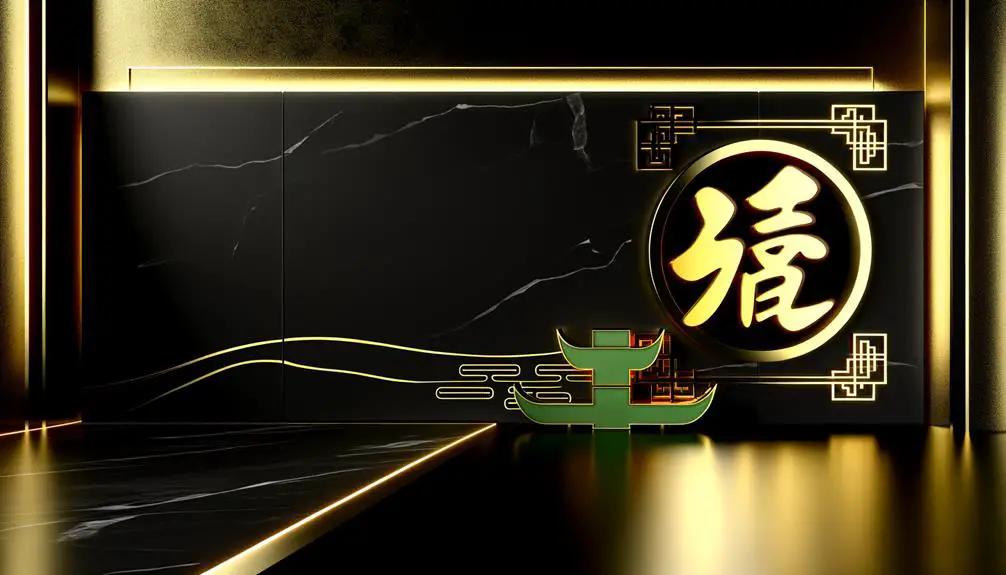
In contemporary society, the Chinese symbol for wealth and prosperity (富) has evolved beyond its traditional confines, embracing new interpretations that resonate with modern values and economic aspirations. This evolution reflects a blend of historical reverence and contemporary relevance, signifying not just material wealth but also holistic well-being and success.
| Modern Interpretation | Traditional Significance | Cultural Relevance |
|---|---|---|
| Financial Success | Material Wealth | Economic Stability |
| Holistic Well-being | Prosperity in Life | Health and Happiness |
| Entrepreneurial Ventures | Abundance and Growth | Innovation and Business Success |
These modern interpretations align with a globalizing world, where the symbol transcends its original cultural boundaries to embody diverse aspects of prosperity in a dynamic socio-economic landscape.
Festivals and Celebrations
The Chinese symbol for wealth and prosperity prominently features in various festivals and celebrations, particularly during the Lunar New Year. Traditional practices such as the exchange of red envelopes (hongbao) filled with money, the consumption of symbolic foods and drinks like fish and dumplings, and intricate customs all underscore the cultural significance of invoking fortune and abundance.
These rituals not only underscore communal values but also perpetuate the historical and cultural reverence for prosperity in Chinese society.
Lunar New Year Traditions
Celebrated with fervor across numerous Asian communities, the Lunar New Year is marked by a plethora of vibrant traditions that symbolize wealth and prosperity, deeply rooted in historical and cultural practices. These customs, passed down through generations, reflect a communal aspiration for a bountiful year ahead.
- Red Envelopes (Hongbao): Gifted to children and unmarried adults, symbolizing luck and fortune.
- Lion and Dragon Dances: Performances intended to ward off evil spirits and invite prosperity.
- Spring Cleaning: Homes are thoroughly cleaned to sweep away bad luck and welcome good fortune.
- Decorations: Red lanterns, couplets, and paper cuttings adorn homes, signifying joy and fortune.
- Fireworks and Firecrackers: Set off to scare away evil spirits and attract wealth.
These traditions encapsulate the essence of communal hope and cultural continuity.
Symbolic Foods and Drinks
Integral to festivals and celebrations, symbolic foods and drinks embody cultural values and aspirations, serving as edible representations of wealth, longevity, and harmony. In Chinese culture, specific foods are meticulously chosen for their auspicious meanings during events such as the Lunar New Year.
For instance, fish symbolizes abundance and surplus, while dumplings and spring rolls represent wealth due to their resemblance to ancient Chinese ingots. Noodles, often uncut, are revered for their association with longevity. Oranges and tangerines, with their golden hue, signify prosperity.
Additionally, rice wine and tea are integral to ritualistic offerings and family gatherings, encapsulating wishes for unity and prosperity. These culinary practices not only enrich festive experiences but also perpetuate cultural heritage and collective values.
Red Envelopes Custom
Enveloped in rich cultural significance, the practice of gifting red envelopes, known as hóngbāo, serves as a powerful symbol of fortune and goodwill during Chinese festivals and celebrations. This custom, deeply rooted in tradition, epitomizes the transfer of blessings and prosperity across generations.
Typically, hóngbāo are presented during the Lunar New Year, weddings, and other festive occasions, with the red color symbolizing luck and warding off evil spirits. The monetary gift inside varies based on the relationship and occasion, adhering to social norms and auspicious numbers.
- Vibrant red envelopes adorned with golden characters
- Crisp banknotes symbolizing new beginnings
- Exchanges between elders and younger generations, fostering familial bonds
- Ceremonial presentations enhancing the celebration's ambiance
- Intricate designs reflecting cultural artistry and heritage
Business and Commerce
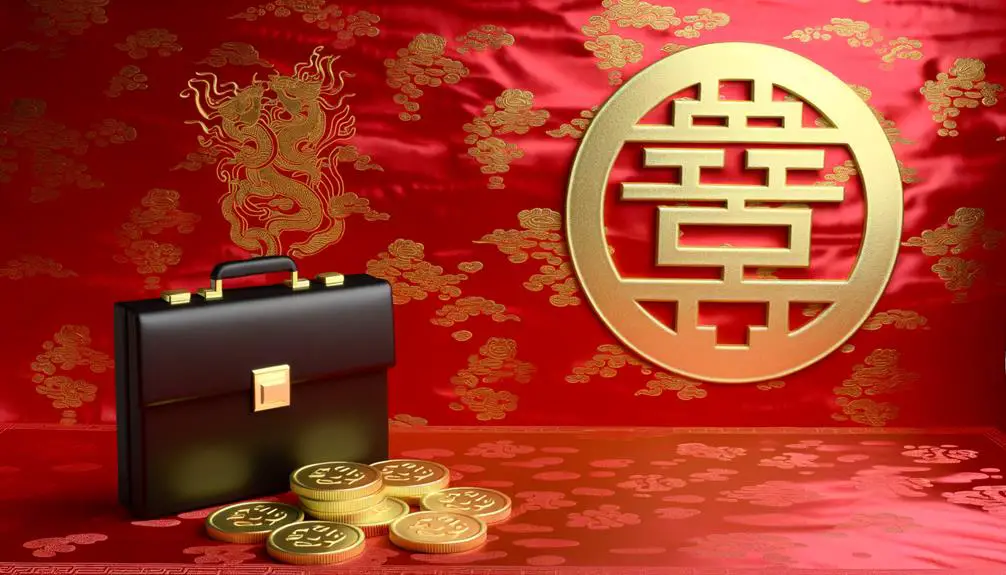
The Chinese symbol for wealth and prosperity, 富 (fù), plays a pivotal role in the domain of business and commerce, often serving as a cultural emblem that influences financial practices, entrepreneurial endeavors, and consumer behavior.
Introduced in various commercial contexts, 富 (fù) is frequently displayed in offices, shops, and business premises to attract financial success and fortuitous outcomes. Its significance extends to contractual agreements and investment strategies, where invoking 富 (fù) is believed to enhance trust and mutual benefit.
The symbol's presence in marketing campaigns and product branding underscores its impact, promising consumers not just material wealth but a holistic sense of prosperity. Consequently, 富 (fù) permeates the business landscape, embodying aspirations of economic growth and success.
Popular Designs
The representation of wealth and prosperity in Chinese culture manifests through various popular designs, each carrying unique historical and aesthetic significance.
Traditional calligraphy styles emphasize the elegance and discipline of ancient scripts, while modern interpretations blend contemporary art forms with classical elements.
Additionally, the strategic placement of these symbols—whether in architectural spaces, personal items, or digital media—plays a pivotal role in enhancing their auspicious impact.
Traditional Calligraphy Styles
In the world of traditional Chinese calligraphy, various styles such as Seal Script (篆书), Clerical Script (隶书), Regular Script (楷书), and Cursive Script (草书) have been revered for their unique aesthetic and symbolic representations of wealth and prosperity. These styles offer a rich tapestry of visual expression, each with distinctive characteristics:
- Seal Script (篆书): Ancient and formal, often used for official seals.
- Clerical Script (隶书): Rectilinear and structured, originating from the Han Dynasty.
- Regular Script (楷书): Clear and readable, the standard for modern Chinese writing.
- Cursive Script (草书): Fluid and expressive, embodying personal style and spontaneity.
- Semi-cursive Script (行书): A blend of Regular and Cursive, balancing readability and artistic flair.
These styles collectively enrich the cultural heritage of Chinese calligraphy.
Modern Interpretations
Building upon the rich heritage of traditional calligraphy styles, modern interpretations of the Chinese symbol for wealth and prosperity have emerged, showcasing innovative designs that blend contemporary aesthetics with timeless cultural significance.
These modern renditions often incorporate sleek lines, minimalist forms, and digital influences, reflecting current artistic trends while preserving the essence of the original characters. Additionally, artists may integrate elements like gold leaf, vibrant color gradients, or three-dimensional effects to enhance visual appeal.
Such designs are frequently utilized in various media, including digital art, fashion, and interior decor, illustrating their adaptability and enduring relevance. This synthesis of old and new underscores the symbol's continuous evolution, mirroring broader cultural shifts and the dynamic nature of Chinese artistic expression.
Symbol Placement Ideas
Often featured in both traditional and contemporary settings, the Chinese symbol for wealth and prosperity is strategically placed to enhance visual harmony and convey cultural significance in various design applications.
This symbol, deeply rooted in Chinese culture, serves as a powerful emblem in interior design, art, and architecture.
Below are some popular placement ideas that integrate this symbol seamlessly into diverse environments:
- Entryway Decorations: Positioned above doorways to welcome prosperity.
- Wall Hangings: Displayed prominently in living rooms or offices.
- Furniture Inlays: Incorporated into the design of tables and cabinets.
- Ceramic Art: Adorning vases and other decorative items.
- Textiles: Embroidered on cushions, curtains, and tapestries.
These placements not only imbue spaces with cultural richness but also invite fortune and success.
Calligraphy Styles
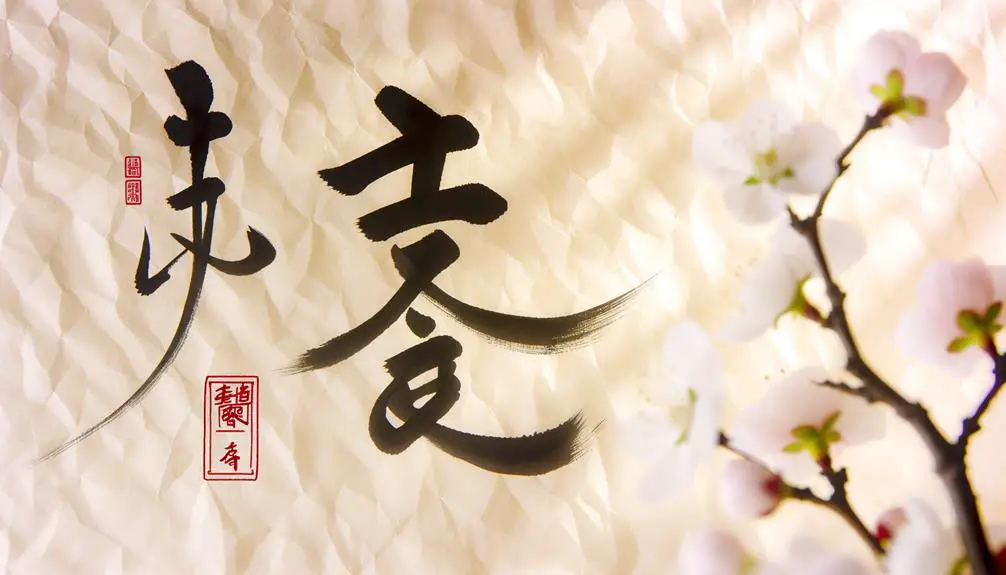
The diverse calligraphy styles employed in the depiction of the Chinese symbol for wealth and prosperity reveal a rich tapestry of historical evolution and cultural significance.
Various forms such as Seal Script (篆书), Clerical Script (隶书), Regular Script (楷书), and Grass Script (草书) each offer unique aesthetic and symbolic nuances.
Seal Script, with its ancient, carved elegance, evokes tradition and permanence. Clerical Script, developed during the Han Dynasty, represents bureaucratic efficiency and stability. Regular Script, widely used for its clarity, symbolizes modernity and accessibility. Grass Script, characterized by its fluidity, conveys spontaneity and artistic freedom.
Each style not only embodies a different historical period but also imparts distinct cultural meanings, enhancing the multifaceted portrayal of wealth and prosperity.
Inspiring Stories
Embedded within the rich tapestry of Chinese history are numerous inspiring stories where the symbol for wealth and prosperity played a pivotal role in shaping individual destinies and community fortunes. These tales often intertwine cultural heritage, folklore, and real-life experiences, illuminating the profound influence of this emblem.
- A humble farmer who discovered an ancient coin inscribed with the symbol, and his life transformed through unexpected fortune.
- A struggling merchant who placed the symbol above his shop's entrance, leading to unprecedented business success.
- A village that united under the symbol during a drought, collectively overcoming adversity.
- A scholar who attributed his academic achievements to calligraphy practices centered around the symbol.
- An immigrant family who carried the symbol overseas, finding prosperity in foreign lands.
These stories underscore the symbol's enduring power.
Conclusion
Conclusively, the Chinese symbol for wealth and prosperity serves as a profound tapestry interwoven with historical significance and cultural richness. Its multifaceted applications, ranging from traditional rituals to modern business practices, underscore its enduring relevance.
Artistic renditions and diverse calligraphy styles further elevate its aesthetic and spiritual dimensions. This emblem, steeped in centuries-old traditions, continues to be a beacon of aspiration and a reflection of the timeless human pursuit of abundance and flourishing.

